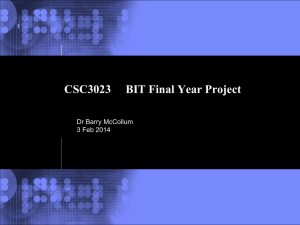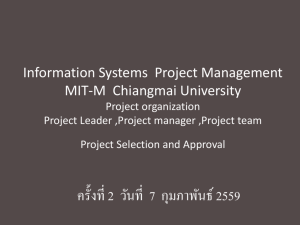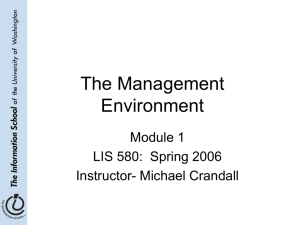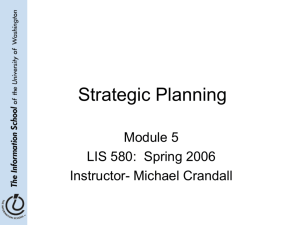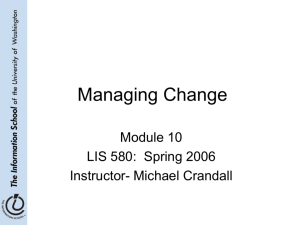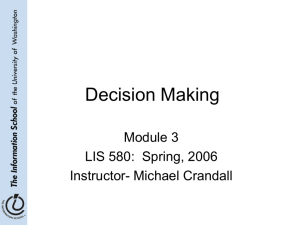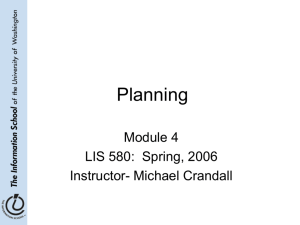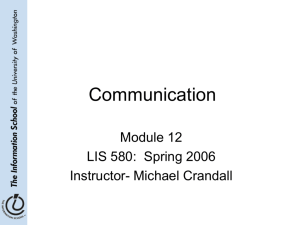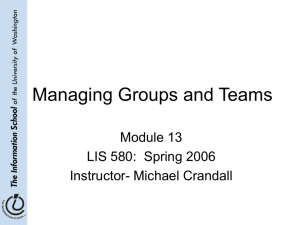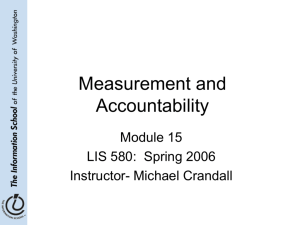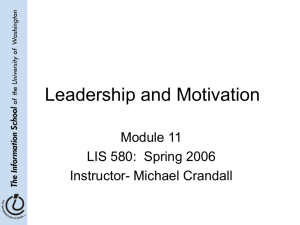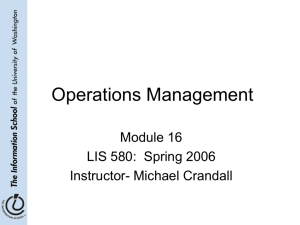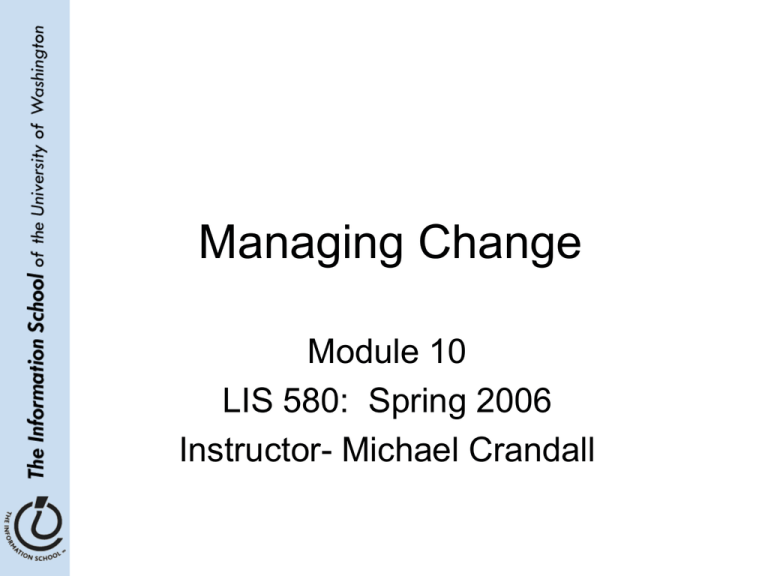
Managing Change
Module 10
LIS 580: Spring 2006
Instructor- Michael Crandall
Roadmap
•
•
•
•
•
•
•
The context
What is organizational change?
Processes for managing change
People and change
Organizational Development
Conflict resolution
Fostering innovation
April 27, 2006
LIS580- Spring 2006
2
Ghoshal & Bartlett
• Old values: compliance, control, contract and
constraint
• New values: discipline, support, trust and stretch
• Successful change involves simplification, integration,
and regeneration
• Phased approach essential, along with focus on
people’s attitudes, assumptions and behaviors
• Brings both organizational design and human
resources lessons to bear
• Ghoshal and Bartlett provide a high-level model for
change, let’s look at some of the details and lessons
learned at a more granular level
April 27, 2006
LIS580- Spring 2006
3
What is Organizational Change?
• An alteration of an organization’s
environment, structure, culture,
technology, or people
– A constant force
– An organizational reality
– An opportunity or a threat
• Change agent
– A person who initiates and assumes the
responsibility for managing a change in an
organization
April 27, 2006
LIS580- Spring 2006
4
Basic Questions for Change
Agents
• What are the forces acting upon me?
– What are the pressures I should take into
consideration as I decide what to change
and how I should change it?
• What should we change?
– Should the changes be strategic and
companywide or relatively limited?
• How should we change it?
– How should we actually implement the
change?
G.Dessler, 2003
April 27, 2006
LIS580- Spring 2006
5
Forces for Change
External Forces
Internal Forces
Competition Laws and
regulations
Strategy modifications
New technologies
New equipment
Labor market shifts
New processes
Business cycles
Workforce composition
Social change
Job restructuring
Compensation and
benefits
Labor surpluses and
shortages
Employee attitude
Prentice Hall, 2002
April 27, 2006
LIS580- Spring 2006
6
Three Categories of Change
Organizational Culture
Prentice Hall, 2002
April 27, 2006
LIS580- Spring 2006
7
Model for Planned Organizational
Change
Source: Adapted from Larry Short, “Planned Organizational Change,” MSU Business Topics, Autumn 1973,
pp. 53–61 ed. Theodore Herbert, Organizational Behavior: Readings and Cases (New York: McMillan, 1976), p. 351.
April 27, 2006
LIS580- Spring 2006
FIGURE 8–1
G.Dessler, 2003
8
Two Views of the Change
Process
• “Calm waters” metaphor
– A description of traditional practices in and
theories about organizations that likens the
organization to a large ship making a
predictable trip across a calm sea and
experiencing an occasional storm
• “White-water rapids” metaphor
– A description of the organization as a small
raft navigating a raging river
Prentice Hall, 2002
April 27, 2006
LIS580- Spring 2006
9
Change in “Calm Waters”
• Kurt Lewin’s Three-Step Process
– Unfreezing
• The driving forces, which direct behavior
away from the status quo, can be
increased
• The restraining forces, which hinder
movement from the existing equilibrium,
can be decreased
• The two approaches can be combined
– Implementation of change
– Refreezing
Prentice Hall, 2002
April 27, 2006
LIS580- Spring 2006
10
Change in “White-water
Rapids”
•
•
•
•
Change is constant in a dynamic environment
The only certainty is continuing uncertainty
Competitive advantages do not last
Managers must quickly and properly react to
unexpected events
– Be alert to problems and opportunities
– Become change agents in stimulating,
implementing and supporting change in the
organization
Prentice Hall, 2002
April 27, 2006
LIS580- Spring 2006
11
Is a New Structure Really Required?
When you identify a problem
with your design, first look for
ways to fix it without
substantially altering it. If that
doesn’t work, you’ll have to
make fundamental changes or
even reject the design. Here’s a
step-by-step process for
resolving problems.
Source: Adapted from Michael Goold and Andrew Campbell, “Do You Have a
Well-Designed Organization?” Harvard Business Review, March 2002, p. 124.
April 27, 2006
LIS580- Spring 2006
FIGURE 8–2
G.Dessler, 2003
12
Is a New Structure Really
Required? (cont’d)
Source: Adapted from Michael Goold and Andrew Campbell, “Do You Have a
Well-Designed Organization?” Harvard Business Review, March 2002, p. 124.
April 27, 2006
LIS580- Spring 2006
FIGURE 8–2b
G.Dessler, 2003
13
A Nine-step Process For Leading
Organizational Change
1. Create a Sense of
Urgency
2. Decide What to Change
3. Create a Guiding
Coalition and Mobilize
Commitment
4. Develop and
Communicate a Shared
Vision
5. Empower Employees to
Make the Change
6. Generate Short-Term
Wins
7. Consolidate Gains and
Produce More Change
8. Anchor the New Ways
of Doing Things in the
Company Culture
9. Monitor Progress and
Adjust the Vision as
Required
G.Dessler, 2003
April 27, 2006
LIS580- Spring 2006
14
Why People Resist Change
Prentice Hall, 2002
April 27, 2006
LIS580- Spring 2006
15
How Immune Is the Person to
Change?
Source: Robert Kegan and Lisa Lahey, “The Real Reason People
Won’t Change,” Harvard Business Review, November 2001, p. 89.
April 27, 2006
LIS580- Spring 2006
FIGURE 8–3
G.Dessler, 2003
16
Dealing with Change
April 27, 2006
LIS580- Spring 2006
G.Dessler, 2003
17
Barriers to Empowerment
Source: Reprinted by permission of Harvard Business School Press. From
Leading Change by John P. Kotter. Boston, MA. 1996, p. 102. Copyright ©
1996 by the President and Fellows of Harvard College, all rights reserved.
April 27, 2006
LIS580- Spring 2006
FIGURE 8–5
G.Dessler, 2003
18
Organizational Development
• Organizational Development (OD)
– An approach to organizational change in
which the employees themselves
formulate the change that’s required and
implement it,
usually with the
aid of a trained
consultant.
G.Dessler, 2003
April 27, 2006
LIS580- Spring 2006
19
OD Interventions
• Human Process Interventions
– Aimed at enabling employees to develop a better
understanding of their own and others’ behaviors
for the purpose of improving that behavior such
that the organization benefits.
• Sensitivity Training (Laboratory or T-groups)
– Purpose is to increase participants’ insight into
their own behavior and that of others by
encouraging an open expression of feelings in a
trainer-guided group.
G.Dessler, 2003
April 27, 2006
LIS580- Spring 2006
20
OD Interventions (cont’d)
• Team Building
– The process of improving the effectiveness
of a team through action research or other
techniques.
• Survey Research
– The process of collecting data from attitude
surveys filled out by employees of an
organization, then feeding the data back to
workgroups to provide a basis for problem
analysis and action planning.
G.Dessler, 2003
April 27, 2006
LIS580- Spring 2006
21
April 27, 2006
LIS580- Spring 2006
G.Dessler, 2003
22
Technostructural Applications of
OD
• Formal Structure Change Program
– An intervention technique in which
employees collect information on existing
formal organizational structures and
analyze it for the purpose of redesigning
and implementing
new organizational
structures.
G.Dessler, 2003
April 27, 2006
LIS580- Spring 2006
23
Strategic Applications of OD
• Strategic Intervention
– An OD application aimed at effecting a suitable fit
among a firm’s strategy, structure, culture, and
external environments.
• Integrated Strategic Management
– An OD program to create or change a company’s
strategy by:
•
•
•
•
Analyzing the current strategy
Choosing a desired strategy
Designing a strategic change plan
Implementing the new plan.
G.Dessler, 2003
April 27, 2006
LIS580- Spring 2006
24
Organizational Stressors:
Role Demands
• Role conflicts
– Work expectations that are hard to satisfy
• Role overload
– Having more work to accomplish than time
permits
• Role ambiguity
– When role expectations are not clearly
understood
Prentice Hall, 2002
April 27, 2006
LIS580- Spring 2006
25
Conflict Handling Styles
Source: Source: Kenneth W. Thomas, “Organizational Conflict,” ed., Steven Kerr, Organizational Behavior (Columbus, OH:
Grid Publishing, 1979), in Andrew DuBrin, Applying Psychology (Upper Saddle River, NJ: Prentice Hall, 2000), p. 223.
April 27, 2006
LIS580- Spring 2006
FIGURE 8–7
G.Dessler, 2003
26
Conflict Resolution Modes
G.Dessler, 2003
April 27, 2006
LIS580- Spring 2006
27
Stimulating Innovation
• Creativity
– The ability to combine ideas in a unique way or to
make unusual connections
• Innovation
– The process of taking a creative idea and turning it
into a useful product, service, or method of
operation
•
•
•
•
Perception
Incubation
Inspiration
Innovation
Prentice Hall, 2002
April 27, 2006
LIS580- Spring 2006
28
Structural Variables Affecting
Innovation
• Organic structures
– Positively influence innovation through less work
specialization, fewer rules and decentralization
• Easy availability of plentiful resources
– Allow management to purchase innovations, bear
the cost of instituting innovations, and absorb
failures
• Frequent inter-unit communication
– Helps to break down barriers to innovation by
facilitating interaction across departmental lines
Prentice Hall, 2002
April 27, 2006
LIS580- Spring 2006
29
Next Week
•
Leading– Monday’s topic is “motivation”
– Read Chapters 10 and 11 and the assigned
articles
•
Discussion group-- think about the following
questions:
– Does NASA have clear and consistent
leadership?
– What are some of the problems with the
leadership structure?
– How do you think this affects the motivation of the
engineers and managers?
– Does this have impact on safety & performance?
– What could be done to improve the situation?
April 27, 2006
LIS580- Spring 2006
30

